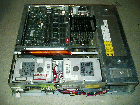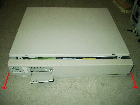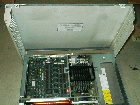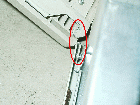HP/9000 425t notes


I've got three machines of this kind, almost identical.
They were a cheap buy, from an architect's bureau, about 50km from where I live,
in 2005 and 2006.
The architect was a nice guy, but a bit disappointed that his machines were only
worth a few Euros, whereas their price was in the several ten thousands
when he purchased them in the early 1990s.
Sorry, but that's life, computers are no capital investment.
The hardware is heavy, mostly solid, made of steel.
Only the front panel is made of plastic and thus is a bit unstable and easily
damaged when removed, so take care.
The machines came quite complete, but I refused to take the associated monitors, because I knew
they would be of little use. Any good quality multisync monitor should be compatible
with the 425t video output, I run one of them with an Eizo L66 flat panel.
The machines did not come with an OS,
but on power-on they booted into some kind of customized architectural software,
apparently written in Basic. It required a password and was of no use for me.
It seems these HP machines were quite popular among architects and engineers.
Pixx



Case opening
The case is somewhat tricky to open.
 Pull (carefully !) the front panel.
Pull (carefully !) the front panel.
 Lift the metal case. Take care, it has a hinge at the rear side.
Not knowing this, I damaged one of my machines this way.
Lift the metal case. Take care, it has a hinge at the rear side.
Not knowing this, I damaged one of my machines this way.
 The case's rear hinge-joint.
The case's rear hinge-joint.
Battery
Memory
There are 8 memory slots which can take proprietary memory modules,
pairwise, in 4 or 8MB size each.
The slots have to be populated with the larger capacity modules
first, i.e. starting with the slots named 0A,0B,1A,1B, etc.
LAN
The 8-fold jumper array
close to the LAN outlet toggles between BNC/AUI output
Last updated: 21-Nov-2008, M.Kraemer





 Pull (carefully !) the front panel.
Pull (carefully !) the front panel.
 Lift the metal case. Take care, it has a hinge at the rear side.
Not knowing this, I damaged one of my machines this way.
Lift the metal case. Take care, it has a hinge at the rear side.
Not knowing this, I damaged one of my machines this way.
 The case's rear hinge-joint.
The case's rear hinge-joint.